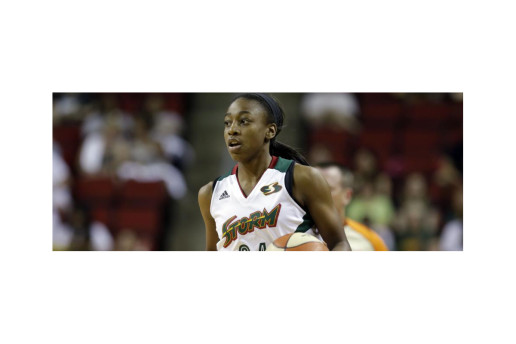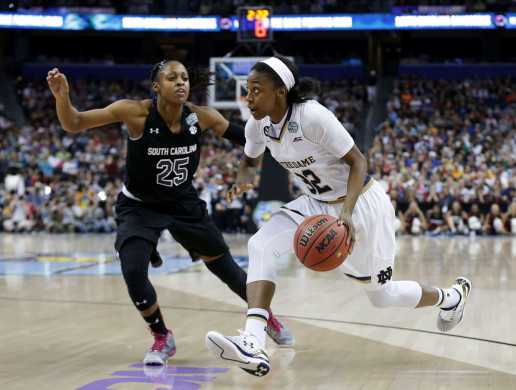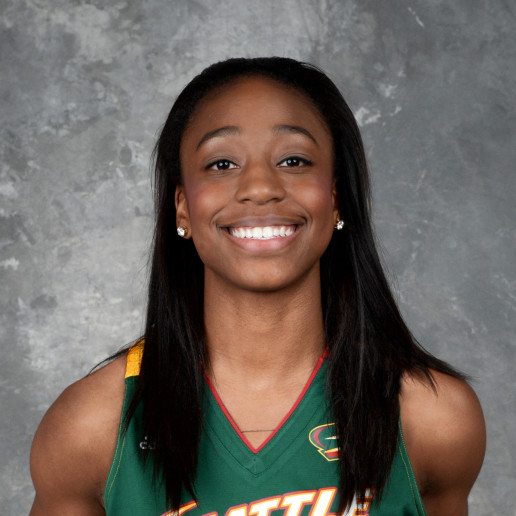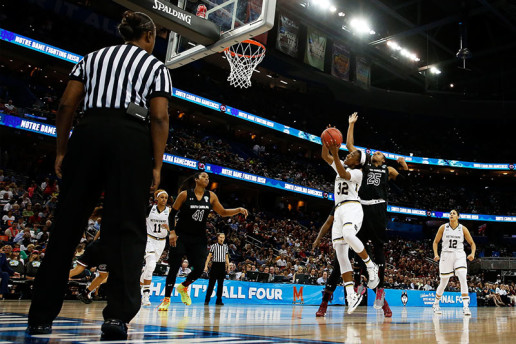Jewell Loyd happy with decision to turn pro
Jewell Loyd always dreamed about playing in the WNBA.
Now she'll get her chance, a little earlier than expected.
Loyd was one of the rare women's basketball players to leave school early to turn pro.
While the announcement came as somewhat of a shock, happening a day after her Notre Dame team lost in the NCAA championship game to Connecticut, Loyd said she spent a lot of time on the decision.
She's totally happy with her choice.
''It's always been a dream of mine to play in the WNBA,'' Loyd said Thursday afternoon before the draft in a sit-down interview with The Associated Press.
''I talked to my family for a long time. It wasn't like I woke up in the morning and decided to do something new. I figured out what was best for me. After talking to my family and bringing up the pros and cons it was the right decision for me.''
Loyd, who went first overall to the Seattle Storm, said the decision had nothing to do with finances. Loyd will make just under $50,000 and could make a few hundred thousand dollars playing overseas.
''Finances had nothing to do with it. That would have not been a good reason to turn pro,'' said Loyd, who was the first Notre Dame player ever taken No. 1 in the draft. ''I just felt it was my time to play at the next level and face the next challenge.''
The All-American said she discussed her choice to turn pro with Notre Dame coach Muffet McGraw and finally told her hours after the Irish lost to UConn of her decision.
''She's like another mother to me and she was clearly disappointed, but she gave me a hug,'' Loyd said.
Loyd said she also told her teammates at Notre Dame who were supportive of her decision. They joked with her about making sure that she doesn't forget about them.
''They told me they had my back and that they understand what I'm doing,'' Loyd said.
It's been a whirlwind week for Loyd since declaring for the draft. She was out in Los Angeles for the Wooden Award and got a chance to meet her idol Kobe Bryant at a Lakers game. The two have been friends on Twitter for months.
''He hit me up on Twitter after the championship game loss and told me to hang in there,'' Loyd said. ''It was great to meet him in Los Angeles.''
Loyd said the two have chatted many times on Twitter and she's honored to call him a mentor.
One thing that Loyd was disappointed about was that she had to miss Notre Dame's final team banquet earlier this week, where she earned MVP honors for the Irish.
''I was sad I didn't get a chance to talk to the fans,'' she said. ''To me this wasn't goodbye, but I'll see you later.''
Loyd said she definitely plans on going back to Notre Dame and finishing her degree.
Tough choices not new for Notre Dame's Jewell Loyd
Jewell Loyd's primary sport as a kid was not basketball. The Notre Dame women's basketball star comes from a tennis family.
Her dad, Calvin, is a tennis instructor. Her mom, Gwen, plays doubles with her sister, Pam, and would frequently beat Jewell and her older brother, Jarryd, in competitive matches.
"That was pretty much the only sport I played up to seventh grade," Loyd told USA TODAY Sports.
Loyd was good enough to have professional aspirations. But basketball was her true passion.
Jarryd, who is seven years older and played at Valparaiso, was active on the hardwood. He realized his sister's passion during pickup games at Drake Park, where they team up to beat college players. Jewell distinctly remembers throwing her brother a no-look pass that he dunked to break a tie in a game to keep the court.
"That was the first time that I felt that emotion and power of being amazed of what I was really able to do (in basketball)," she said. "That was my first memory of the love of the game."
She had to make a decision about which one to continue playing competitively: tennis or basketball.
Loyd chose basketball.
After two national championship appearances, a 103-5 record at Notre Dame and an ACC Player of the Year award later, it appears she made the right call.
When Notre Dame lost to Connecticut in the national championship game, Loyd was faced with another choice: Return for another year with the Irish and compete for a national title, or declare for the WNBA draft and begin her professional career.
"I told her to do what makes you happy," Jarryd said. "If you're not having fun and you're looking to grow, you've got to make these decisions."
She chose to turn pro, and became one of the few able to declare early.
Loyd was allowed to declare for the draft early because she turns 22 in the same calendar year as the draft (She will be 22 in October).
This decision needed to be made much faster than her decision to quit competitive tennis. The WNBA mandates that if a player is going to declare early for the draft, they must do so 10 days before the draft, unless they are still playing, then they have 24 hours after their final game to decide. The national title game was played 10 days before the draft, so Loyd needed to decide if she would turn pro by the next day.
Jarryd, who runs his own youth basketball training academy based in Chicago and played overseas professionally, was heavily involved in the conversations with his sister.
"It's a quick turnaround," he said. "There has to be a lot of mentorship involved in this type of decision. It is a quick turnaround because the season is right around the corner. I'm not saying this is a trend that's starting, but it might be."
"Maybe this is something the WNBA should be looking at in terms of timetable because potentially more student athletes are looking at more the developmental side, In order to develop to their maximum potential, I think the WNBA should fostering those types of relationships. "
Jewell, who averaged 19.8 points and 5.3 rebounds for the Fighting Irish, is predicted to be the No. 1 pick. The Seattle Storm, which has a history of great guards with former UConn player Sue Bird, has the No. 1 and No. 3 picks this season.
"Wherever I decide to go, I'm bringing the same thing I brought in high school and Notre Dame, some offense, defense, and definitely a smile and a laugh," Jewel said.
While some WNBA players go abroad in their offseason, Jarryd joked that his sister might have other plans.
"We actually threw some stuff around now about her potentially finding a doubles partners and playing tennis," he said
INSIDE ACCESS: NIKE WOMEN PROPEL BASKETBALL
Nike’s three-decade commitment to women’s basketball continues to grow in 2015 with new athletes and products. The legacy built on campaigns, product innovation, athlete partnerships and team championships, evolves with a new chapter.
THE FUTURE OF WOMEN'S BASKETBALL
2015 No. 1 WNBA Draft pick and new Nike athlete, Jewell Loyd.
As the WNBA season kickoff nears, Nike proudly announces the signing of Jewell Loyd, this year’s No. 1 draft pick selected by Seattle. The electrifying 21-year-old guard from Chicago joins Amanda Zahui Bazoukou (No. 2 pick to Tulsa), Kaleena Mosqueda-Lewis (No. 3 pick to Seattle) and Elizabeth Williams (No. 4 pick to Connecticut) as part of the Nike Basketball family of 50 female athletes across the WNBA’s 12 teams.
“To represent Nike Basketball is a dream come true,” said Loyd. “I’m looking forward to contributing product insight and teaming with the entire Nike family of athletes to inspire kids on and off the court.”
‘IF YOU LET ME PLAY’ INSPIRES GIRLS
Nike targeted girls’ sports and the need to establish a level playing field in 1995. That year it launched its thought-provoking television commercial, “If You Let Me Play.” The provocative ad featured young girls sharing the importance of being allowed to participate in sports with statistics such as “If you let me play, I will be 60 percent less likely to get breast cancer; I will suffer less depression, if you let me play sports. I will be more likely to leave a man who beats me.”
The campaign was seen by 73 million viewers and triggered an outpouring of mail and phone calls to Nike’s headquarters. It also received praise from a variety of organizations, such as Girls, Inc. and the President’s Conference on Youth, Drugs and Violence.
The ad’s theme resonated with then-teenager Diana Taurasi, who has become one of basketball’s most accomplished athletes. She’s earned three NCAA championships, three WNBA titles, three Olympic gold medals and five Euro League titles. Taurasi led the University of Connecticut Huskies to win 95 percent of their games (139) from 2000-2004, while closely informing the team’s product evolution in both uniforms and shoes.
Diana Taurasi after winning a gold medal in London with USA.
“I’m proud to be a part of Nike’s strong legacy in women’s basketball,” says Taurasi. “Since my freshman year at UConn in 2000 until now, I take my partnership with Nike seriously. My hope is to see even more girls playing the game in the U.S. and abroad and I’m starting to see this in Russia.”
ATHLETE INSIGHT FUELS PRODUCT INNOVATION
In 1993, Nike signed several female athletes, including Mia Hamm, Jackie Joyner Kersee and basketball phenom Sheryl Swoopes. Nike used ads like this one to introduce her to the world.
Listening to the voice of the athlete and innovating new product helps Nike Basketball stay sharp. The best player of her generation, Sheryl Swoopes was the first female basketball player to receive a Nike Basketball signature shoe, the Nike Air Swoopes, in 1996.
“The Air Swoopes was inspired by Sheryl's tenacity and her desire to be in the face of her competition. I went to Lubbock, Texas, to experience her life, her family and friends. She was a tough girl with a sweet side,” says Marni Gerber, designer of the shoe.
Nike Basketball's first women's signature shoe, the Air Swoopes, designed for Sheryl Swoopes.
The design included an uncompromising blend of support, performance and style: a rugged black Durabuck midfoot stability strap that cradled the foot, contrasting color-blocking for maximum visibility, and Nike Air in the heel and forefoot. When the inaugural WNBA season kicked off, men sought the Nike Air Swoopes in larger sizes — a glorious example of role reversal. As the Swoopes series evolved, implementing Zoom and Tuned Air along the way, gender became irrelevant as athletes gravitated towards the shoe despite being built for a female.
NEW APPAREL COLLECTION AUTHENTIC TO WOMEN
New women's basketball apparel obsesses freedom of movement with premium fabrics, an obsession for Nike Basketball as seen in the Hyper Elite uniforms that debuted in Feb. 2015.
This fall, Nike will introduce new basketball apparel designed by women for women. The new silhouettes feature premium performance fabrics and deliver a superior fit and range of movement.
Nike draws on feedback from a variety of basketball players at all levels of the game, from amateur to professional. Female athletes provide insight to designers that directly informs product innovation with authentic inspiration. The UConn women’s basketball team directly informed the fit and feel of the new Nike women’s products debuting later this year.
Nike’s current roster of top women’s basketball athletes often engages in product concepting and testing, including Seimone Augustus, Sue Bird, Tamika Catchings, Tina Charles, Elena Delle Donne, Skylar Diggins, Candice Dupree, Brittney Griner, Angel McCoughtry, Nneka Ogwumike, Odyssey Sims and Lindsay Whalen.
WOMEN’S GAME EXPANDS INTERNATIONALLY
Women’s basketball participation and popularity has grown domestically and internationally, now with more than one-quarter of all players according to the Sports and Fitness Industry Association (SFIA). Athletes serve as role models on and off the court around the world. In fact, many professionals play both in the WNBA and international leagues in Europe and China, with one season often rolling into the next.
Tina Charles, Nike athlete for five years, uses her success on the court as an avenue to build awareness for an important cause. The 2012 gold medalist and WNBA MVP, who plays in New York and Turkey, educates others about the importance of heart health awareness following the death of her aunt, Maureen “Hopey” Vaz. Charles’s Hopey’s Heart Foundation began in the U.S. and is making inroads internationally with an educational platform and automated external defibrillator machine grant program that has placed over 140 units in schools, gyms and community centers.
Tina Charles, three-time WNBA All-Star.
“Sometimes in life, you have to lose in order to gain,” says Charles. “I’m determined to use my voice and my late aunt’s memory to improve sports safety and raise awareness of sudden cardiac arrest throughout the world.”
Elena Delle Donne is extremely active in her community as the WNBA season concludes and she forgoes playing abroad. She works as a global ambassador for the Special Olympics, a cause with a personal connection since Delle Donne’s sister, Lizzie, has cerebral palsy and is autistic, blind and deaf. Delle Donne participates in several Special Olympic clinics and events including basketball clinics held in Chicago; she earned the 2014 Dawn Staley Community Leadership Award in recognition of her outstanding work in the community.
Charles and Delle Donne are just two of many athletes in Nike Basketball’s family using their stature as female athletes to elevate important causes.
BASKETBALL’S FUTURE IS NOW
A shining example of the past informing the future is the mentorship that has already begun between eight-time All-Star Sue Bird and rookie Jewell Loyd, now backcourt mates in Seattle and fellow Nike athletes.
Sue Bird, eight-time WNBA All-Star, has won three gold medals.
Bird is guiding Loyd through the transition to the pros; a metaphoric torch passing to a future star whose career officially begins on June 6 in Los Angeles.
“The future is bright for Jewell and we’re lucky to have her in Seattle and with the Nike family,” says Bird.
Nike’s role in women’s basketball continues to evolve with new athletes, insight-driven products and experiences that evolve the game.
Role Model
I was 12 years old when my mom thought something might be wrong.
It was an ordinary summer — hot, sticky — just outside of Chicago. I was a typical kid — energetic, playful — enjoying the months between seventh and eighth grades. My life revolved around two things: sports and school. The former came naturally to me. Whether it was basketball or soccer, every athletic endeavor was like breathing. I didn’t have to think about it. My body and mind operated together, almost independent of any thought.
Imagine yourself walking — down the street, from your couch to the kitchen, or even from your car to a store entrance. You don’t have to think about each step. Your body just takes over. That’s what it’s like when I have a ball in my hands or when I’m on the court. Every movement and action is fluid.
School wasn’t as automatic. I listened to my teachers intently and loved to learn, but it seemed to take me far more time and deliberate thought than my classmates to complete simple tasks. Homework? That took hours.
My mother, a teacher, noticed.
One day, she told me that she was taking me to a facility for some tests. There would be cards, some colors, puzzles. This will be fun, I thought. I was young. These were games to me and I love a challenge.
We arrived at the facility, checked in and got started. A couple of specialists told me to relax and answer everything as best I could. We went through flash cards, color tests, numbers and puzzles. I remember laughing and enjoying myself but still not understanding fully why I was there. The tests got harder. I was confused. It might sound strange, but my mind felt … broken. Something wasn’t right.
Days later, my mom got the test results back. She sat me down. A stack of paperwork neatly organized into folders separated us. I stared at the pile. What’s going on? I thought.
She told me I had dyslexia.
I still didn’t understand.
She explained that it’s a learning disability that affects someone’s ability to read. That I comprehend letters and numbers differently. Suddenly it made sense why, even though I understood concepts, I’d always had trouble when it came to organizing words and numbers on paper. This is why math isn’t my friend! I thought. I’d always enjoyed school, especially math, but getting through the work could be a struggle. I’d get frustrated during classroom assignments. My friends would be done in 15 minutes, and I’d still be on the first couple of problems. Teachers even called me lazy.
But that one word hung in the air: disability.
What are my friends going to say? Is this going to change what they or my teachers think of me? How they treat me? At that age, you’re so invested in other people’s opinions of you. Think about the social implications of having a disorder that manifests in everyday tasks like reading or writing and also requires special treatment, yet it’s unseen. An invisible disability. I was afraid people would think I was stupid.
An invisible disability. I was afraid people would think I was stupid.
How could I — someone who genuinely enjoyed learning and who wanted to do well in school — have this? What would it mean for the rest of school? College? It seemed unfair.
Adolescence is hard enough without a learning disability. It affected almost every aspect of my life. I tried to hide it. I was ashamed. You can only go so long before your friends start to suspect something. I was part of a really close circle of guy friends — we literally grew up together. I’d already disclosed my disability to the school faculty. I was actually the first person at my school to share a diagnosis, thanks to my parents, so we’d begun trying different specialized learning plans.
My friends knew something was up. Finally, I told them why I was getting the extra help. I was dyslexic. It took some explaining, but they couldn’t have been more supportive. Why was I so afraid?
Even as I figured out what learning strategies worked for me, every day at school was tough, and I took out all of my aggression on the basketball court. I lived in the gym because that was the one place I was absolutely confident. I felt at home there. I worked for hours on my shot, on my handle, on my passing and on my defense. I imagined game situations. Hitting big shots. And then I’d do it again the next day. And the next. It was my sanctuary.
And then it clicked: the work ethic I had in the gym, the emphasis on repetition and visualization, was something I could apply to my studies. I developed strategies for overcoming my disability.
On the court, if I got beat on defense, I made sure it wasn’t going to happen again. If I couldn’t get through a book in three weeks, I was still going to finish it. Believe me, no book is going to sit on my dresser having gone unfinished. That confidence to never quit learning came from basketball.
College was sort of the great unknown. I wanted to play basketball at the Division I level and graduate from college, and I was excited by scholarship offers. I was also excited just to be a student. In fact, the first thing my mother and I did when deciding on which school I’d attend was develop a full-fledged plan with the school to ensure my academic success. If a school didn’t accommodate my academic needs, they were struck from the list.
One of the first meetings I had at Notre Dame wasn’t even about basketball — it was with the academic office and basketball relations to strategize on a plan. We discussed individualized learning plans, and everything fell into place. Throughout my entire academic career, Notre Dame made sure that I had all of the learning materials I needed and more. They made sure I was on top of my studies. I even made academic honor roll. In many ways, I’m more proud of that than any award or accomplishment on the court.
No book is going to sit on my dresser having gone unfinished. That confidence to never quit learning came from basketball.
Fast forward from that hot summer 10 years ago, and here I am, on the morning of a new life adventure: the WNBA. It’s always been a dream of mine to play professional basketball. And even though I am leaving early, I will absolutely get my degree from Notre Dame and look forward to the day I can hang it on my wall.
My path has been full of challenges, and frankly, I’m not sure if I’d be here without my disability. That was a driving force for all those hard, long hours in the gym. It motivated me to prove I could be successful. My achievements are a testament to my own hard work and the support and sacrifice from those around me, and hopefully now, a source of inspiration for those who struggle with or know someone who struggles with any sort of learning disability. I want to use my platform as a professional athlete to help erase the stigma and motivate people to pursue their dreams regardless of the roadblocks they face.
After being diagnosed, it took time to figure out what worked for me, but I did. And if I close my eyes right now, I can see the back of my future jersey: Loyd. I won’t know what the front will say for another few hours, but the title I want to carry above all others?
Role model.



